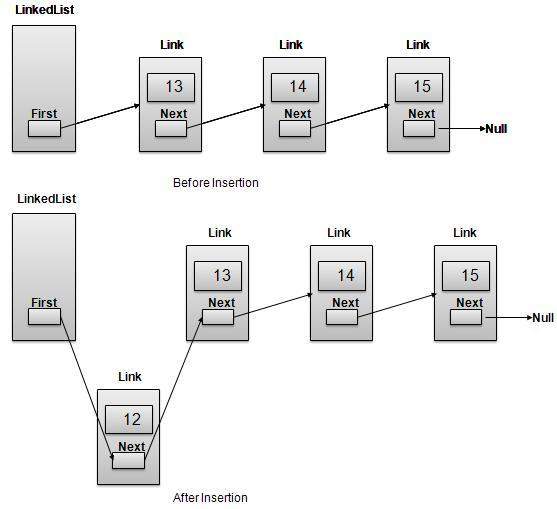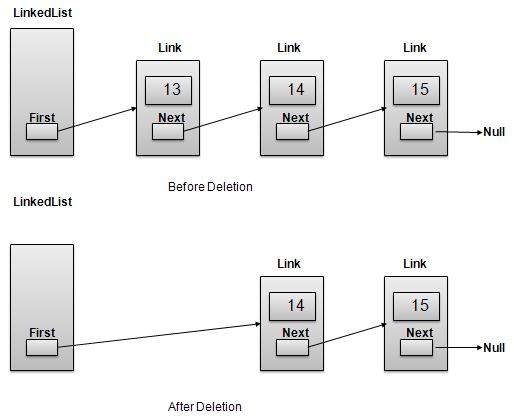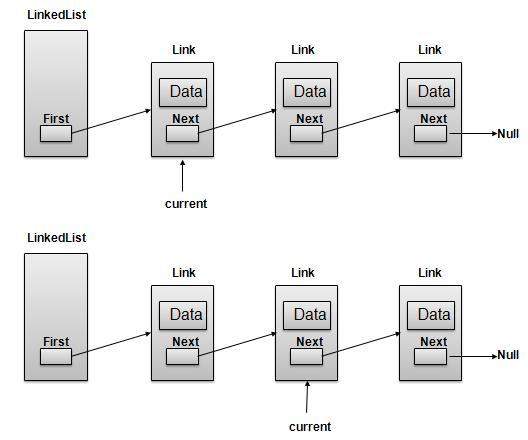Linked List Basics
Linked List is a sequence of links which contains items. Each link contains a connection to another link. Linked list the second most used data structure after array. Following are important terms to understand the concepts of Linked List.
- Link − Each Link of a linked list can store a data called an element.
- Next − Each Link of a linked list contain a link to next link called Next.
- LinkedList − A LinkedList contains the connection link to the first Link called First.
Linked List Representation

As per above shown illustration, following are the important points to be considered.
- LinkedList contains an link element called first.
- Each Link carries a data field(s) and a Link Field called next.
- Each Link is linked with its next link using its next link.
- Last Link carries a Link as null to mark the end of the list.
Learn Java in-depth with real-world projects through our Java certification course. Enroll and become a certified expert to boost your career.
Types of Linked List
Following are the various flavours of linked list.
- Simple Linked List − Item Navigation is forward only.
- Doubly Linked List − Items can be navigated forward and backward way.
- Circular Linked List − Last item contains link of the first element as next and and first element has link to last element as prev.
Basic Operations
Following are the basic operations supported by a list.
- Insertion − add an element at the beginning of the list.
- Deletion − delete an element at the beginning of the list.
- Display − displaying complete list.
- Search − search an element using given key.
- Delete − delete an element using given key.
Insertion Operation
Insertion is a three step process:
- Create a new Link with provided data.
- Point New Link to old First Link.
- Point First Link to this New Link.

//insert link at the first location
public void insertFirst(int key, int data){
//create a link
Link link = new Link(key,data);
//point it to old first node
link.next = first;
//point first to new first node
first = link;
}Deletion Operation
Deletion is a two step process:
- Get the Link pointed by First Link as Temp Link.
- Point First Link to Temp Link’s Next Link.

//delete first item
public Link deleteFirst(){
//save reference to first link
Link tempLink = first;
//mark next to first link as first
first = first.next;
//return the deleted link
return tempLink;
}Navigation Operation
Navigation is a recursive step process and is basis of many operations like search, delete etc.:
- Get the Link pointed by First Link as Current Link.
- Check if Current Link is not null and display it.
- Point Current Link to Next Link of Current Link and move to above step.

Note
//display the list
public void display(){
//start from the beginning
Link current = first;
//navigate till the end of the list
System.out.print("[ ");
while(current != null){
//print data
current.display();
//move to next item
current = current.next;
System.out.print(" ");
}
System.out.print(" ]");
}Advanced Operations
Following are the advanced operations specified for a list.
- Sort − sorting a list based on a particular order.
- Reverse − reversing a linked list.
- Concatenate − concatenate two lists.
Sort Operation
We’ve used bubble sort to sort a list.
public void sort(){
int i, j, k, tempKey, tempData ;
Link current,next;
int size = length();
k = size ;
for ( i = 0 ; i < size - 1 ; i++, k-- ) {
current = first ;
next = first.next ;
for ( j = 1 ; j < k ; j++ ) {
if ( current.data > next.data ) {
tempData = current.data ;
current.data = next.data;
next.data = tempData ;
tempKey = current.key;
current.key = next.key;
next.key = tempKey;
}
current = current.next;
next = next.next;
}
}
}Reverse Operation
Following code demonstrate reversing a single linked list.
public LinkedList reverse() {
LinkedList reversedlist = new LinkedList();
Link nextLink = null;
reversedlist.insertFirst(first.key, first.data);
Link currentLink = first;
// Until no more data in list,
// insert current link before first and move ahead.
while(currentLink.next != null){
nextLink = currentLink.next;
// Insert at start of new list.
reversedlist.insertFirst(nextLink.key, nextLink.data);
//advance to next node
currentLink = currentLink.next;
}
return reversedlist;
}Concatenate Operation
Following code demonstrate reversing a single linked list.
public void concatenate(LinkedList list){
if(first == null){
first = list.first;
}
if(list.first == null){
return;
}
Link temp = first;
while(temp.next !=null) {
temp = temp.next;
}
temp.next = list.first;
}Demo
Link.java
package com.tutorialspoint.list;
public class Link {
public int key;
public int data;
public Link next;
public Link(int key, int data){
this.key = key;
this.data = data;
}
public void display(){
System.out.print("{"+key+","+data+"}");
}
}LinkedList.java
package com.tutorialspoint.list;
public class LinkedList {
//this link always point to first Link
//in the Linked List
private Link first;
// create an empty linked list
public LinkedList(){
first = null;
}
//insert link at the first location
public void insertFirst(int key, int data){
//create a link
Link link = new Link(key,data);
//point it to old first node
link.next = first;
//point first to new first node
first = link;
}
//delete first item
public Link deleteFirst(){
//save reference to first link
Link tempLink = first;
//mark next to first link as first
first = first.next;
//return the deleted link
return tempLink;
}
//display the list
public void display(){
//start from the beginning
Link current = first;
//navigate till the end of the list
System.out.print("[ ");
while(current != null){
//print data
current.display();
//move to next item
current = current.next;
System.out.print(" ");
}
System.out.print(" ]");
}
//find a link with given key
public Link find(int key){
//start from the first link
Link current = first;
//if list is empty
if(first == null){
return null;
}
//navigate through list
while(current.key != key){
//if it is last node
if(current.next == null){
return null;
}else{
//go to next link
current = current.next;
}
}
//if data found, return the current Link
return current;
}
//delete a link with given key
public Link delete(int key){
//start from the first link
Link current = first;
Link previous = null;
//if list is empty
if(first == null){
return null;
}
//navigate through list
while(current.key != key){
//if it is last node
if(current.next == null){
return null;
}else{
//store reference to current link
previous = current;
//move to next link
current = current.next;
}
}
//found a match, update the link
if(current == first) {
//change first to point to next link
first = first.next;
}else {
//bypass the current link
previous.next = current.next;
}
return current;
}
//is list empty
public boolean isEmpty(){
return first == null;
}
public int length(){
int length = 0;
for(Link current = first; current!=null;
current = current.next){
length++;
}
return length;
}
public void sort(){
int i, j, k, tempKey, tempData ;
Link current,next;
int size = length();
k = size ;
for ( i = 0 ; i < size - 1 ; i++, k-- ) {
current = first ;
next = first.next ;
for ( j = 1 ; j < k ; j++ ) {
if ( current.data > next.data ) {
tempData = current.data ;
current.data = next.data;
next.data = tempData ;
tempKey = current.key;
current.key = next.key;
next.key = tempKey;
}
current = current.next;
next = next.next;
}
}
}
public LinkedList reverse() {
LinkedList reversedlist = new LinkedList();
Link nextLink = null;
reversedlist.insertFirst(first.key, first.data);
Link currentLink = first;
// Until no more data in list,
// insert current link before first and move ahead.
while(currentLink.next != null){
nextLink = currentLink.next;
// Insert at start of new list.
reversedlist.insertFirst(nextLink.key, nextLink.data);
//advance to next node
currentLink = currentLink.next;
}
return reversedlist;
}
public void concatenate(LinkedList list){
if(first == null){
first = list.first;
}
if(list.first == null){
return;
}
Link temp = first;
while(temp.next !=null) {
temp = temp.next;
}
temp.next = list.first;
}
}LinkedListDemo.java
package com.tutorialspoint.list;
public class LinkedListDemo {
public static void main(String args[]){
LinkedList list = new LinkedList();
list.insertFirst(1, 10);
list.insertFirst(2, 20);
list.insertFirst(3, 30);
list.insertFirst(4, 1);
list.insertFirst(5, 40);
list.insertFirst(6, 56);
System.out.print("\nOriginal List: ");
list.display();
System.out.println("");
while(!list.isEmpty()){
Link temp = list.deleteFirst();
System.out.print("Deleted value:");
temp.display();
System.out.println("");
}
System.out.print("List after deleting all items: ");
list.display();
System.out.println("");
list.insertFirst(1, 10);
list.insertFirst(2, 20);
list.insertFirst(3, 30);
list.insertFirst(4, 1);
list.insertFirst(5, 40);
list.insertFirst(6, 56);
System.out.print("Restored List: ");
list.display();
System.out.println("");
Link foundLink = list.find(4);
if(foundLink != null){
System.out.print("Element found: ");
foundLink.display();
System.out.println("");
}else{
System.out.println("Element not found.");
}
list.delete(4);
System.out.print("List after deleting an item: ");
list.display();
System.out.println("");
foundLink = list.find(4);
if(foundLink != null){
System.out.print("Element found: ");
foundLink.display();
System.out.println("");
}else{
System.out.print("Element not found. {4,1}");
}
System.out.println("");
list.sort();
System.out.print("List after sorting the data: ");
list.display();
System.out.println("");
System.out.print("Reverse of the list: ");
LinkedList list1 = list.reverse();
list1.display();
System.out.println("");
LinkedList list2 = new LinkedList();
list2.insertFirst(9, 50);
list2.insertFirst(8, 40);
list2.insertFirst(7, 20);
list.concatenate(list2);
System.out.print("List after concatenation: ");
list.display();
System.out.println("");
}
}If we compile and run the above program then it would produce following result:
Original List: [ {6,56} {5,40} {4,1} {3,30} {2,20} {1,10} ]
Deleted value:{6,56}
Deleted value:{5,40}
Deleted value:{4,1}
Deleted value:{3,30}
Deleted value:{2,20}
Deleted value:{1,10}
List after deleting all items: [ ]
Restored List: [ {6,56} {5,40} {4,1} {3,30} {2,20} {1,10} ]
Element found: {4,1}
List after deleting an item: [ {6,56} {5,40} {3,30} {2,20} {1,10} ]
Element not found. {4,1}
List after sorting the data: [ {1,10} {2,20} {3,30} {5,40} {6,56} ]
Reverse of the list: [ {6,56} {5,40} {3,30} {2,20} {1,10} ]
List after concatenation: [ {1,10} {2,20} {3,30} {5,40} {6,56} {7,20} {8,40} {9,50} ]
Leave a Reply